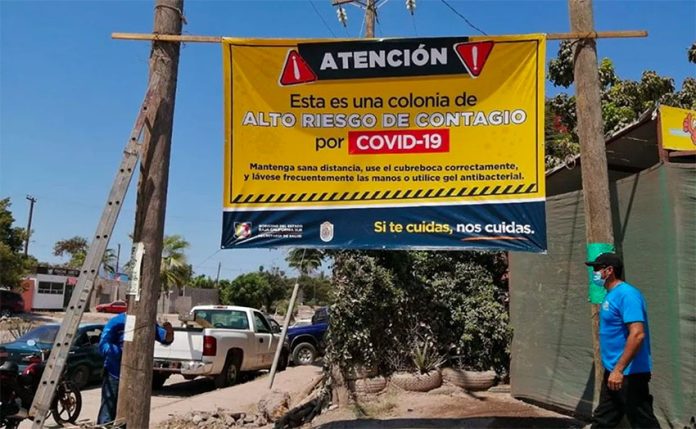Baja California Sur (BCS) health officials have not only begun providing a neighborhood-by-neighborhood breakdown of coronavirus infections on the state’s website, but they are also hanging banners in neighborhoods experiencing outbreaks, warning residents to use extreme caution.
“This measure will provide additional information to citizens so that they can take precautions when leaving their home, especially in areas where there is a greater transmission of the coronavirus,” said Health Minister Víctor George Flores.
The placement of these banners has drawn controversy, El Universal reports. Residents have complained on social media that they are discriminatory actions and could have repercussions.
The added warnings come as cases continue to increase in the state.
Yesterday, health authorities confirmed 151 new coronavirus cases, with 89 in La Paz, 34 in Los Cabos, seven in Comondú, six in Loreto and three in Mulegé, bringing the number of accumulated cases to 5,954.
Seven people died yesterday, five in La Paz and two in Los Cabos, and the total number of deaths in the state is at 241. Health authorities say 133 patients have been discharged from hospitals and a total of 3,043 have recovered.
Once again, BCS has the highest per capita rate of infections in Mexico with 137.42 confirmed cases per 1,000 residents. The next highest rate is in Coahuila, with 78.8 per 1,000
Twenty-two doctors arrived in La Paz from Querétaro and Mexico City this week to help treat coronavirus patients.
The state has 251 available hospital beds and 171 ventilators. Currently, 75 ventilators are in use.
Junk food ban proposed
Following the lead of Oaxaca, which banned the sale and distribution of junk food to minors earlier this month, the president of the congressional education commission, Esteban Ojeda Ramírez, told BCS Noticias that the Morena party intends to present a similar bill in September.
At least 10 other states in Mexico are considering junk food bans for minors as a way to curb Mexico’s epidemic of obesity and diabetes, which is especially prevalent in BCS.
“Baja California Sur is in first place for consumption of soft drinks and junk food and obesity and childhood diabetes rates are among the highest ranges in the country,” Ojeda said.
Busted
In the month of July, 23 drug dealers were arrested and more than 12,200 doses of narcotics were seized in BCS. Of the drugs seized, 1o,888 doses were methamphetamine, and 1,378 were marijuana. Ten of those arrested were women, BCS Noticias reports.
Not arrested although publicly shamed, BCS Noticias reports, was a tourist identified only as Amanda who explained a controversial photo with a somewhat fishy backstory.
Last week, Amanda posted to her Instagram account a shot of her at Balandra beach in La Paz, proudly holding a parrotfish she said she would be eating with portabello mushrooms. Of her 29,000 followers, some 800 “liked” the photo.

However, Balandra, like all beaches in BCS except for those in Los Cabos, is closed. Also, Balandra bay was named a UNESCO World Heritage Site in 2005 and is a protected area that has been closed to fishing since 2012.
Shortly after she posted the photo, Amanda added a comment claiming she had actually caught the brightly colored, still glistening fish at a location some hours away and decided to travel to Balandra to snap the photo.
Still not busted
Shortly after President López Obrador’s visit to Los Cabos last Friday, someone again opened San José del Cabo’s estuary to the sea over the weekend, draining it of fresh water and leaving rotting bodies of fish behind.
Businesswoman and activist Blanca Pedrín, who has long fought to protect the estuary and other natural areas in Los Cabos, lamented that the estuary had once again been “raped, taken away by intentionally and deliberately emptying it; you can see how they deliberately opened the mouth of our estuary, opening furrows to empty it.”
Rafael Vázquez of Mexico United for its Beaches said that repeated requests to reinforce the sand bar that protects the estuary, a haven for birds and other wildlife species, and increase surveillance to prevent acts of vandalism have been met with deaf ears by the city council.
Despite the installation of two thermal imaging cameras in July, the damage continues unchecked and no culprit has been identified.
The estuary, which has been a protected area since 1993, was one of the region’s first draws for foreign visitors centuries ago when Spanish galleons and pirate ships would stop to replenish their water supplies as they traveled the trade route between Mexico and the Philippines. It is also a source of water to farmers in the area and sits on a coveted parcel of beachfront property.
Turtle time
August is the high season for sea turtle spawning off the coast of Los Cabos, and visitors and residents are reminded to respect the nests they lay on beaches. Manager of the Marine Turtle Protection Program, Graciela Tiburcio Pintos, said that more than 250 nests in Los Cabos and the Pacific coast have been penned off to protect the eggs.
Tiburcio urges beachgoers to reduce their consumption of plastic, keep their dogs on a leash and refrain from driving along the beach. Often school children are invited to help release baby turtles and learn how to protect them from extinction, but the coronavirus may put a damper on that program for now, she said.
Mexico News Daily
